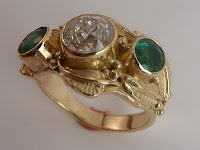
In my last posting I told you about some boulder opals I had just gotten in and that I was pretty excited about having some new material to make earrings with. I also told you a few postings ago that if you wanted my new designs, you really had to get in here quickly. This week I put out three new pairs of opal earrings. The ones at the top of the page are boulder opal and rubies in 18k and 22k gold. And I'm sorry but you can't have them because I put them out on Wednesday and they sold on Friday.
The pair below this paragraph have the really spicy pair of boulder opals I was talking about in the last post and my assistant Katy got a really pretty amazing picture showing some of the astounding color flash in the stones. This pair will not last long either.


And I also just put out the pair pictured below this paragraph as well this week. This is one of my comet series of earrings (although I have customers who say they are my bug earrings). These stones were not boulder opal splits, but a larger stone that I had cut in half (and that retained its color properly).
The following is a blog post I started quite awhile ago on opals. It talks a bit about opals in general and white opals specifically. I'll get something up soon that discusses black opals.
If you asked me what my favorite colored stone was I would have a really hard time choosing between sapphires and opals. Admittedly they are completely different types of stones but they both move me in a myriad of ways. And opals, without a doubt, have a slight edge simply because they aren't just ONE color but they are MANY colors. Some of them have ALL the colors. I mean, what more can you ask for in a gem material? Well okay, they could be a whole lot more durable and they could hold up better over time, but still they are just so fascinating. And they have so many colors!!!
Well actually the nice opals have so many colors. For many of you opal means those ugly white stones that have some specks of greens, blues or reds in them. But that just means you haven't seen any of my boulder opals or the astronomically priced black opals that show up occasionally. So what the heck are opals anyway you might ask? And I'm glad you asked because I intend to tell you what they are. They are beautiful!!! Ooops sorry I was actually going to get scientific here.
Opal is an amorphous, hydrous form of silica. Basically what that means is that it has some water in it. The amount of water, and the crystallization of it, will effect the opal in a variety of ways. It is believed that the play of color comes about because of the diffraction of light and slight variations of refractive index from a large amount of spherical, regularly arranged particles of silica and from the voids between. Okay enough science. It's great to know this but it doesn't amount to a hill of beans when you want to own an opal!
There are actually a variety of types of opal that are available. The ones most people may be familiar with are white opal, boulder opal, black opal, crystal opal and fire opal. All of these are broken up into even more varieties but it isn't really that important for a non gemologist to know.
White opals, the most common of the opal family, are opals that have a white (sometimes described as milky) body color with flashes of color scattered throughout. There is a huge amount of this material available but much of it is either so milky that there isn't much play of color or there just isn't much color in it to begin with. This is not to say that there isn't some beautiful white opal out there. I have owned, at various times, many fine pieces with strong color flashes throughout the stones, but generally speaking because the background is white the colors simply don't show up that well. Often if you coated the back with black ink (or set them with black behind them) you could see a lot more colors. If this is being done to the opal, however, it must absolutely be disclosed to the customer as it is a misrepresentation of the goods if it isn't revealed. I never did this with stones that I sold, unless it was going into a custom piece for someone and they specifically requested it, but it was always pretty amazing how much of a difference you would see in the play of color when it was done.






